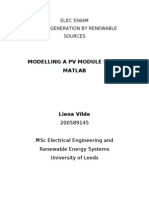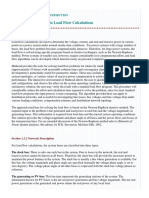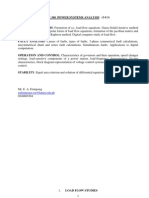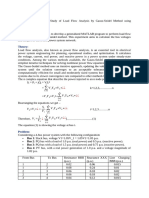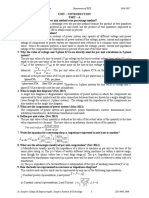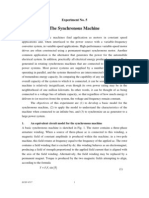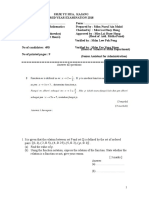Formation of Jacobian Matrix: 1) X (N + N 1) - The Dimensions
Uploaded by
Sampurna DasFormation of Jacobian Matrix: 1) X (N + N 1) - The Dimensions
Uploaded by
Sampurna DasFormation of Jacobian Matrix Let us assume that an n -bus power system contains a total np number of P-Q buses while
the number of P-V (generator) buses be ng such that n = np + ng + 1. Bus-1 is assumed to be the slack bus. We shall further use the mismatch equations of Pi and Qi given in (4.9) and (4.10) respectively. The approach to Newton-Raphson load flow is similar to that of solving a system of nonlinear equations using the Newton-Raphson method: At each iteration we have to form a Jacobian matrix and solve for the corrections from an equation of the type given in (4.27). For the load flow problem, this equation is of the form
where the Jacobian matrix is divided into submatrices as
It can be seen that the size of the Jacobian matrix is ( n + np 1) x ( n + np 1). The dimensions of the submatrices are as follows: J11: (n 1) (n 1) J12: (n 1) np J21: np (n 1) J22: np np
The submatrices of jacobian matrix are
Algorithm for Load Flow solution using N-R method The Newton-Raphson procedure is as follows: Step-1: Choose the initial values of the voltage magnitudes |V| (0) of all np load buses and n 1 angles (0) of the voltages of all the buses except the slack bus. Step-2: Use the estimated |V|(0) and (0) to calculate a total n 1 number of injected real power Pcalc(0) and equal number of real power mismatch P (0) . Step-3: Use the estimated |V| (0) and (0) to calculate a total np number of injected reactive power Qcalc(0) and equal number of reactive power mismatch Q (0) . Step-3: Use the estimated |V| (0) and (0) to formulate the Jacobian matrix J (0) . Step-4: Solve (4.30) for (0) and |V| (0) |V| (0). Step-5 : Obtain the updates from
Step-6: Check if all the mismatches are below a small number. Terminate the process if yes. Otherwise go back to step-1 to start the next iteration with the updates given by step-5
Formation of Y bus by Singular Transformation
The primitive network matrices are the most basic matrices and depend purely on the impedance or admittance of the individual elements. However, they do not contain any information about the behaviour of the interconnected network variables. Hence, it is necessary to transform the primitive matrices into more meaningful matrices which can relate variables of the interconnected network. In the bus frame of reference, the performance of the interconnected network is described by n independent nodal equations, where n is the total number of buses (n+ 1, nodes are present, out of which one of them is designated as the reference node). For example a 5-bus system will have 5 external buses and 1 ground/ ref. bus). The performance equation relating the bus voltages to bus current injections in bus frame of reference in admittance form is given by IBUS = YBUS EBUS (1)
Where, EBUS = vector of bus voltages measured with respect to reference bus IBUS = Vector of currents injected into the bus YBUS = bus admittance matrix The performance equation of the primitive network in admittance form is given by i + j = [y] v Pre-multiplying by At (transpose of A), we obtain At i +At j = At [y] v (2) However, using KCL for the node, At i =0, since it indicates a vector whose elements are the algebraic sum of element currents incident at a bus, which by Kirchhoffs law is zero. Similarly, At j gives the algebraic sum of all source currents incident at each bus and this is nothing but the total current injected at the bus. Hence, At j = IBUS (3) Thus from (1) and (2) we have, IBUS = At [y] v (4) However, we can write branch voltage as: v =A EBUS And hence substituting in (3) we get, IBUS = At [y] A EBUS (5) Comparing (5) with (1) we obtain, YBUS = At [y] A (6) The bus incidence matrix is rectangular and hence singular. Hence,(6) gives a singular transformation of the primitive admittance matrix [y] i.e. Y-Bus matrix for the system.
You might also like
- Exp - No: Date: Power Flow Analysis by Newton-Raphson Method AimNo ratings yetExp - No: Date: Power Flow Analysis by Newton-Raphson Method Aim72 pages
- Load Technique: Reliable Flow For RadialNo ratings yetLoad Technique: Reliable Flow For Radial7 pages
- The Power Flow Equations 1.0 The Admittance Matrix: Current Injections at A Bus Are Analogous To Power Injections. TheNo ratings yetThe Power Flow Equations 1.0 The Admittance Matrix: Current Injections at A Bus Are Analogous To Power Injections. The29 pages
- Notes On Power System Load Flow Analysis Using An Excel WorkbookNo ratings yetNotes On Power System Load Flow Analysis Using An Excel Workbook20 pages
- 1 - 3a Load Flow Calculations - Theory PDFNo ratings yet1 - 3a Load Flow Calculations - Theory PDF4 pages
- Experiment No.3 Date: Formation of Bus Admittance and Impedance Matrices and Solution of Networks AIMNo ratings yetExperiment No.3 Date: Formation of Bus Admittance and Impedance Matrices and Solution of Networks AIM25 pages
- Subject-Power System 2 Subject Code - 3EE11 Faculty - Ajay Patel SirNo ratings yetSubject-Power System 2 Subject Code - 3EE11 Faculty - Ajay Patel Sir60 pages
- New Contributions To Load Flow Studies by The Method of Reduction and RestorationNo ratings yetNew Contributions To Load Flow Studies by The Method of Reduction and Restoration7 pages
- Power Flow Analysis of RDS by Artificial Network Technique: Vaishali Holkar, Dr. Deepika MasandNo ratings yetPower Flow Analysis of RDS by Artificial Network Technique: Vaishali Holkar, Dr. Deepika Masand5 pages
- Annotated-Power Systems Project %28ELEN4018A%29No ratings yetAnnotated-Power Systems Project %28ELEN4018A%2911 pages
- Power System Analysis: Newton-Raphson Power FlowNo ratings yetPower System Analysis: Newton-Raphson Power Flow28 pages
- Power System Analysis: Newton-Raphson Power FlowNo ratings yetPower System Analysis: Newton-Raphson Power Flow28 pages
- Method For Load-Flow Solution of Radial Distribution NetworksNo ratings yetMethod For Load-Flow Solution of Radial Distribution Networks8 pages
- A Simplified Forward and Backward Sweep ApproachNo ratings yetA Simplified Forward and Backward Sweep Approach5 pages
- Problems in Quantum Mechanics: Third EditionFrom EverandProblems in Quantum Mechanics: Third EditionD. ter Haar3/5 (2)
- Multi-Area Frequency and Tie-Line Power Flow Control by Fuzzy Gain Scheduled SMESNo ratings yetMulti-Area Frequency and Tie-Line Power Flow Control by Fuzzy Gain Scheduled SMES16 pages
- The Synchronous Machine: Experiment No. 5No ratings yetThe Synchronous Machine: Experiment No. 510 pages
- Some applications of functional analysis in mathematical physics 3rd ed Edition S. L. Sobolev all chapter instant download100% (2)Some applications of functional analysis in mathematical physics 3rd ed Edition S. L. Sobolev all chapter instant download81 pages
- Sin (Cos (Tan (: θ O pposite H ypotenuse θ A djacent H ypotenuse θ O pposite A djacentNo ratings yetSin (Cos (Tan (: θ O pposite H ypotenuse θ A djacent H ypotenuse θ O pposite A djacent4 pages
- RD Sharma Solutions For Class 8 Chapter 6 Algebraic Expressions and IdentitiesNo ratings yetRD Sharma Solutions For Class 8 Chapter 6 Algebraic Expressions and Identities57 pages
- Get Lecture & Note-Taking Guide: To Accompany Calculus Concepts, 13th Edition Sherry Biggers - Ebook PDF Free All Chapters100% (4)Get Lecture & Note-Taking Guide: To Accompany Calculus Concepts, 13th Edition Sherry Biggers - Ebook PDF Free All Chapters19 pages
- RS-Aggarwal-Class-12-Maths-Chapter-4.-Inverse-Trigonometric-Functions100% (1)RS-Aggarwal-Class-12-Maths-Chapter-4.-Inverse-Trigonometric-Functions73 pages
- Bargmann, On A Hilbert Space of Analytic Functions and An Associated Integral TransformNo ratings yetBargmann, On A Hilbert Space of Analytic Functions and An Associated Integral Transform101 pages
- Ncert Solutions Class 11 Maths Chapter 8 Binomial TheoremNo ratings yetNcert Solutions Class 11 Maths Chapter 8 Binomial Theorem34 pages
- Basis Functions: Introduction To Group TheoryNo ratings yetBasis Functions: Introduction To Group Theory21 pages
- L'Hopital's Rule and Implicit Differentiation Test Review #2 1No ratings yetL'Hopital's Rule and Implicit Differentiation Test Review #2 114 pages
- G08 Week 1 - Q2 - Linear Inequality in Two VariablesNo ratings yetG08 Week 1 - Q2 - Linear Inequality in Two Variables57 pages
- Exp - No: Date: Power Flow Analysis by Newton-Raphson Method AimExp - No: Date: Power Flow Analysis by Newton-Raphson Method Aim
- The Power Flow Equations 1.0 The Admittance Matrix: Current Injections at A Bus Are Analogous To Power Injections. TheThe Power Flow Equations 1.0 The Admittance Matrix: Current Injections at A Bus Are Analogous To Power Injections. The
- Notes On Power System Load Flow Analysis Using An Excel WorkbookNotes On Power System Load Flow Analysis Using An Excel Workbook
- Experiment No.3 Date: Formation of Bus Admittance and Impedance Matrices and Solution of Networks AIMExperiment No.3 Date: Formation of Bus Admittance and Impedance Matrices and Solution of Networks AIM
- Subject-Power System 2 Subject Code - 3EE11 Faculty - Ajay Patel SirSubject-Power System 2 Subject Code - 3EE11 Faculty - Ajay Patel Sir
- New Contributions To Load Flow Studies by The Method of Reduction and RestorationNew Contributions To Load Flow Studies by The Method of Reduction and Restoration
- Power Flow Analysis of RDS by Artificial Network Technique: Vaishali Holkar, Dr. Deepika MasandPower Flow Analysis of RDS by Artificial Network Technique: Vaishali Holkar, Dr. Deepika Masand
- Method For Load-Flow Solution of Radial Distribution NetworksMethod For Load-Flow Solution of Radial Distribution Networks
- Problems in Quantum Mechanics: Third EditionFrom EverandProblems in Quantum Mechanics: Third Edition
- Multi-Area Frequency and Tie-Line Power Flow Control by Fuzzy Gain Scheduled SMESMulti-Area Frequency and Tie-Line Power Flow Control by Fuzzy Gain Scheduled SMES
- Some applications of functional analysis in mathematical physics 3rd ed Edition S. L. Sobolev all chapter instant downloadSome applications of functional analysis in mathematical physics 3rd ed Edition S. L. Sobolev all chapter instant download
- Sin (Cos (Tan (: θ O pposite H ypotenuse θ A djacent H ypotenuse θ O pposite A djacentSin (Cos (Tan (: θ O pposite H ypotenuse θ A djacent H ypotenuse θ O pposite A djacent
- RD Sharma Solutions For Class 8 Chapter 6 Algebraic Expressions and IdentitiesRD Sharma Solutions For Class 8 Chapter 6 Algebraic Expressions and Identities
- Get Lecture & Note-Taking Guide: To Accompany Calculus Concepts, 13th Edition Sherry Biggers - Ebook PDF Free All ChaptersGet Lecture & Note-Taking Guide: To Accompany Calculus Concepts, 13th Edition Sherry Biggers - Ebook PDF Free All Chapters
- RS-Aggarwal-Class-12-Maths-Chapter-4.-Inverse-Trigonometric-FunctionsRS-Aggarwal-Class-12-Maths-Chapter-4.-Inverse-Trigonometric-Functions
- Bargmann, On A Hilbert Space of Analytic Functions and An Associated Integral TransformBargmann, On A Hilbert Space of Analytic Functions and An Associated Integral Transform
- Ncert Solutions Class 11 Maths Chapter 8 Binomial TheoremNcert Solutions Class 11 Maths Chapter 8 Binomial Theorem
- L'Hopital's Rule and Implicit Differentiation Test Review #2 1L'Hopital's Rule and Implicit Differentiation Test Review #2 1
- G08 Week 1 - Q2 - Linear Inequality in Two VariablesG08 Week 1 - Q2 - Linear Inequality in Two Variables
